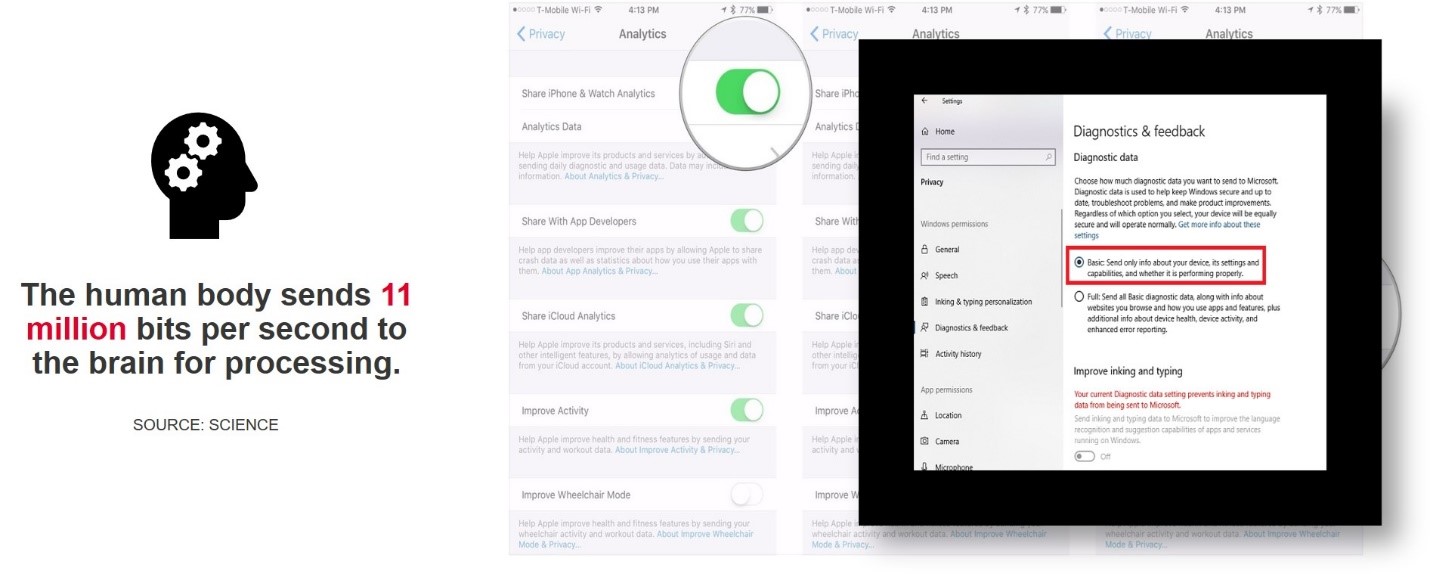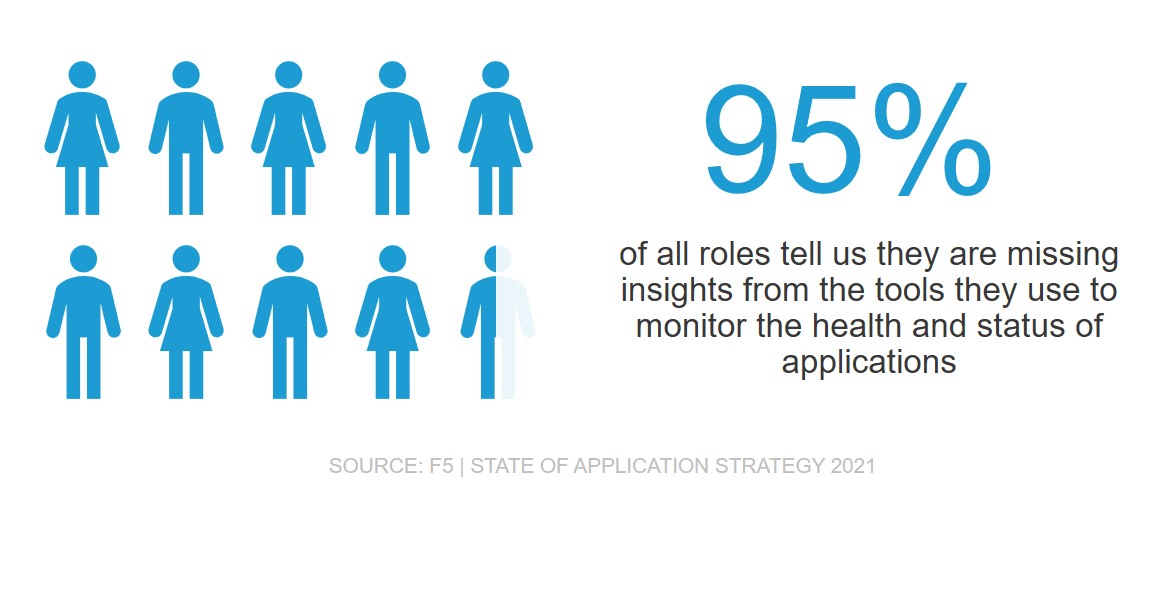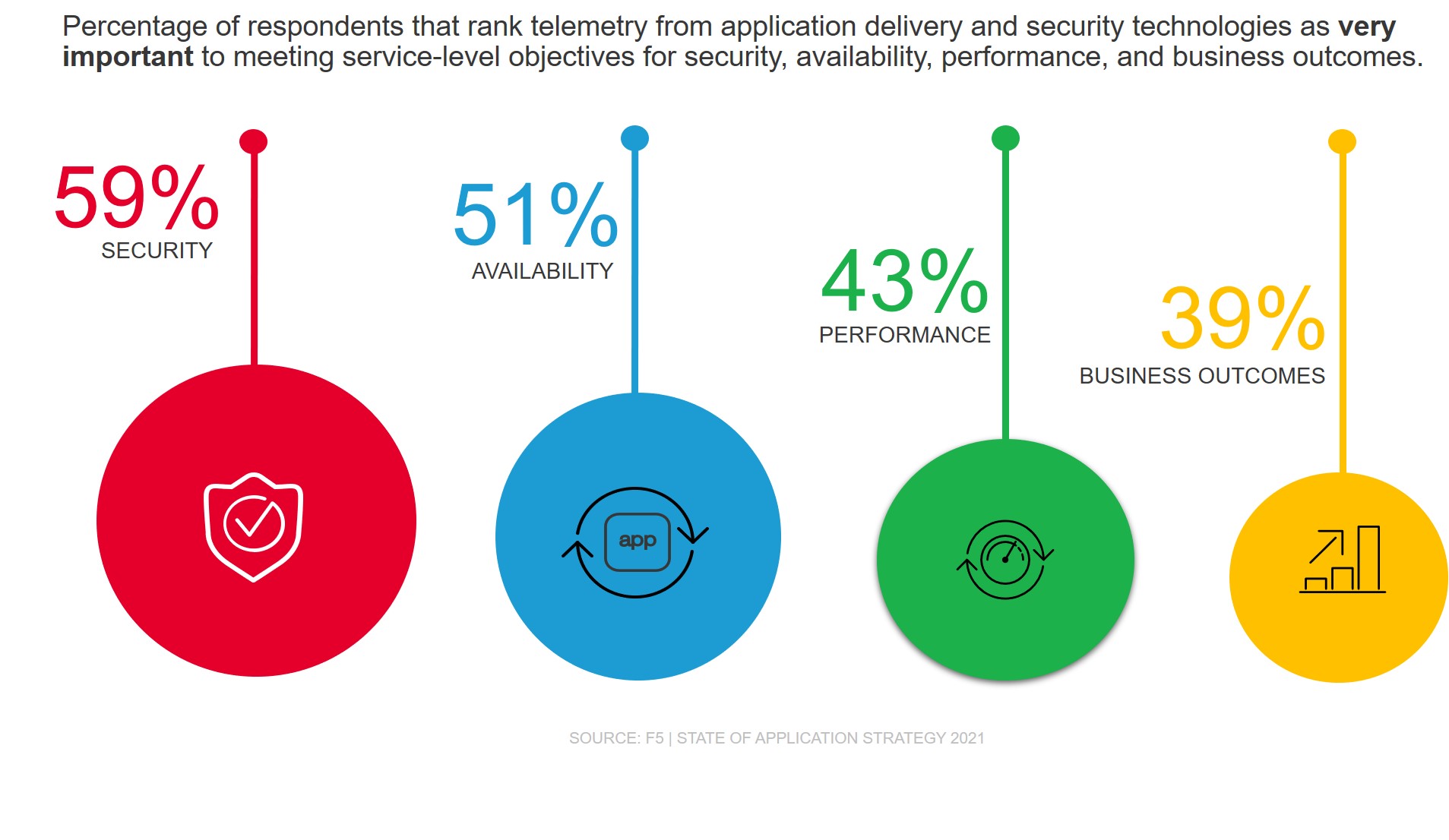La estrategia sobre el estado de las aplicación en 2021: Midiendo lo que importa
Los conocimientos surgen del análisis de datos. Tenga en cuenta que ahora mismo, mientras lee esto, su cuerpo humano está generando alrededor de 11 millones de bits de “datos” por segundo. Eso equivale aproximadamente a 1,3 MB, lo que equivale a un poco más de 1 KB. A modo de comparación, la entrada de registro promedio para una transacción de aplicación es de 1 KB. Como un organismo vivo, cada acción de una aplicación genera datos. Solicitudes, respuestas, errores, advertencias, estado. Lo mismo ocurre con los servicios y la infraestructura que entregan y protegen una aplicación. La cantidad de telemetría generada por una sola interacción de aplicación es mayor a la que nuestros cerebros pueden captar y procesar, que los científicos creen que es de alrededor de 50 a 60 bits por segundo.
Pero esa es la parte interesante. No tenemos que procesar conscientemente los datos que generan nuestros cuerpos. Tenemos todo tipo de ayudantes internos que procesan y actúan en nuestro nombre, automáticamente. No tienes que pensar en respirar ni en forzar tu corazón a bombear. No decides de repente que tienes hambre: algún sistema interno (oculto) te alerta de esa realidad. Cada sistema tiene sus ayudantes.

Si piensa en la telemetría, recordará haber visto solicitudes de ayudantes todo el tiempo: para diagnósticos, para análisis, para rendimiento, para obtener más datos. Cada proveedor de tecnología aprovecha todos los datos que puede obtener para mejorar y optimizar sus productos.
En el ámbito empresarial no debería ser diferente. Para un negocio digital, uno de sus productos es la experiencia del cliente . Necesitará datos para comprender cómo y cuándo escalar y optimizar y, por supuesto, para protegerlos.
Al igual que el cuerpo humano, no esperamos que una aplicación produzca y analice todos los datos necesarios para optimizar y proteger la experiencia digital. Esperamos que haya ayudantes que recopilen, analicen e instruyan a los sistemas para que hagan eso para la aplicación.
El mercado coincide en que algunas de las mejores ayudas son la seguridad de las aplicación y las tecnologías de distribución.
La telemetría es importante. Período.
Analytics es una estrella tecnológica en ascenso. Es fundamental para todo, desde la inteligencia artificial hasta la seguridad y la gestión de su cartera de aplicaciones. Reconociendo su importancia, este año hicimos muchas preguntas sobre los datos, cómo se utilizan y qué le falta al mercado.
Resulta que lo que falta es, bueno, mucho.

Los encuestados nos dijeron que les faltaban conocimientos que les ayudaran a identificar las causas fundamentales de la degradación del rendimiento (49%), los incidentes que causan interrupciones (51%) y los posibles ataques (45%). Y, sin embargo, la mayoría de estos encuestados (59%) también nos dijeron que tienen las herramientas que necesitan para monitorear la salud y el estado de sus aplicaciones.
Esta desconexión no se debe a una falta de herramientas o de datos, sino a una falta de procesamiento analítico que vaya más allá de la visualización para ofrecer información y, en última instancia, conocimientos. Si bien casi todas las herramientas proporcionan una visualización de puntos de datos que nos indican el estado de una aplicación (activo, inactivo, lento, rápido, etc.), generalmente no tenemos las herramientas necesarias para brindar información más profunda, como la causa raíz o anomalías que indiquen un posible ataque.
La importancia que se le dio a la telemetría fue omnipresente, pero observamos que su importancia fue mayor para los objetivos de nivel de servicio (SLO) operativos en lugar de aquellos utilizados para satisfacer los resultados comerciales.

Sospechamos que el énfasis en las métricas tradicionales es sólo eso: un énfasis en medir la efectividad de TI y de las operaciones basadas en métricas individuales y, podríamos agregar, binarias.
Mide lo que importa
Lo que medimos debe cambiar.
La disponibilidad de una aplicación determinada, por ejemplo, puede tener un impacto en la experiencia del cliente. Pero puede que no. Las metodologías modernas como Agile y DevOps y las prácticas de SRE están impulsadas, en parte, por la expectativa de que los componentes fallarán. La capacidad de compensar automáticamente está incorporada en las aplicaciones modernas y en las tecnologías que las proporcionan y las protegen. Pero este principio clave aún no ha sido adoptado plenamente por el área de TI y operaciones y, según nuestro análisis, por los altos ejecutivos. La gente trabaja en función de lo que se les mide. Si los líderes miden su efectividad organizacional basándose en métricas tradicionales, entonces esas métricas determinarán las prioridades. Y eso es lo que estamos viendo en nuestra investigación.
Esto es preocupante dado el importante movimiento de modernización que estamos viendo. A medida que avanzan rápidamente los esfuerzos de modernización, el énfasis necesariamente se desplaza de las aplicaciones a los flujos de trabajo, de las interfaces de usuario a las experiencias de usuario. La mejor medida de la experiencia del usuario no son las métricas binarias de disponibilidad o rendimiento, sino los resultados comerciales. Las métricas operativas tradicionales, cuando se agregan y analizan, pueden proporcionar la información necesaria para cumplir con las expectativas de resultados comerciales. Pero por sí solas, las métricas tradicionales son poco más que alertas de advertencia que pueden o no indicar un problema real.
Lo que es peor es que muchas organizaciones ni siquiera supervisan la salud y el estado de los componentes que utilizan para modernizar las aplicaciones comerciales principales. Casi una cuarta parte (24%) nos dijo que no realizan un seguimiento de los SLA de los componentes modernos que crean las experiencias de usuario actuales. Estos componentes (generalmente aplicaciones móviles y nativas de contenedores) son la primera impresión que tiene un usuario de una marca. Y, sin embargo, un porcentaje significativo de organizaciones no intenta comprender esa experiencia. Un porcentaje no trivial (6%) no realiza ningún seguimiento de los SLA. Para cualquier cosa.
Según algunas anécdotas, creo que he usado algunas de esas aplicaciones y luego las he eliminado.
Otras organizaciones están rastreando métricas de componentes que usted esperaría:
- 62% de tiempo de respuesta
- 60% de confiabilidad
- 59% de tiempo de actividad
En general, aprendimos dos cosas de nuestra investigación de este año: primero, la telemetría de los "ayudantes" (tecnologías de seguridad y entrega de aplicación ) es un componente fundamental para que TI y el negocio midan el éxito. En segundo lugar, las organizaciones reconocen que las herramientas que tienen a su disposición no están descubriendo la información crítica que las empresas y TI necesitan para brindar experiencias digitales extraordinarias.
Conclusión: La analítica debe evolucionar junto con el negocio
La transformación digital es un viaje empresarial acompañado de una evolución tecnológica. Las empresas y las TI deben recorrer el mismo camino: hacia la digitalización. Para llegar al destino (un negocio asistido por IA) se requiere una asociación entre TI y el negocio. Esa asociación incluye una alineación en materia de análisis que cambia la estrategia para centrarse en los resultados comerciales en lugar de las métricas operativas.
Hay mucha más información sobre análisis y telemetría y cómo las organizaciones los utilizan (y desearían poder utilizarlos) en nuestro informe oficial de 2021 . Échale un vistazo y no olvides volver a visitarnos aquí, ya que a continuación nos adentraremos en la automatización.
